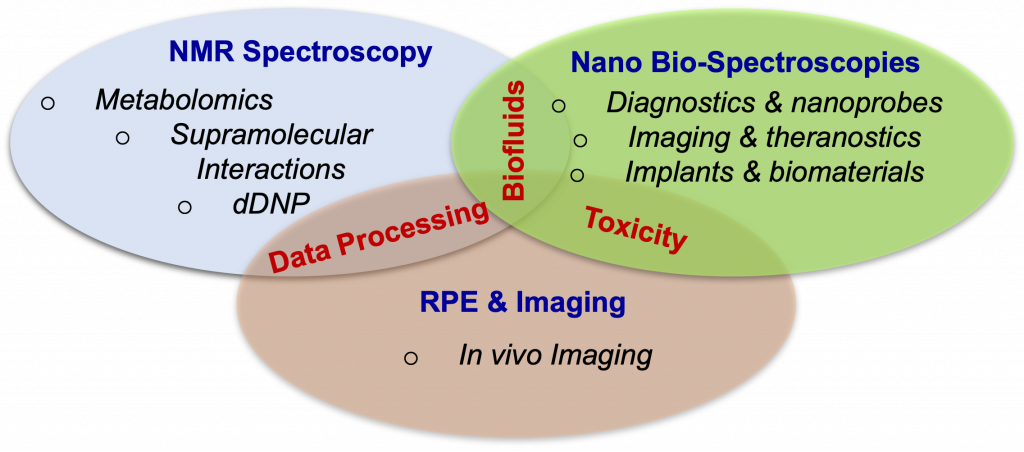Bio-Spectroscopy
Team composition
Team Leaders
Thematic Groups
Nuclear Magnetic Resonance Spectroscopy

N.Giraud, Pr
M. Baudin, IR
G. Bertho, IR
C. Caradeuc, AI
F. Kateb, MCU
M. El Hayek, PhD
L. Gutierrez, PhD

C. Mangeney, Pr
P. Nizard, IR
D. Onidas, MCU
Y. Luo, CR
H. Chen, PhD (coll. Dr. F. Gazeau)
G. Li, Post-doc
K. Pandey, PhD (Co-dir. Pr. N. Félidj, Université Paris Cité)
Y. Zhang, PhD (Co-dir. Dr. Graciela Pavon-Djavid)

Y. Frapart, IR, HDR
P. Collin, MCU‐PH

Presentation of the Research Team
 Recent developments in technology, experimental methodologies, but also data processing management and analysis have opened the way to new breakthroughs in the field of biospectroscopy. However, many challenges remain in biomarker identification, sample preparation, instrumentation, biomarkers identification and data handling. With our broad range of state-of-the-art equipment (NMR, EPR and micro-Raman) and robust collaborations with doctors and biologists, the BIOSPECTROSCOPY team drives the development of advanced biospectroscopy analysis and imaging. Moreover, we develop a synergetic approach by combining different types of spectroscopiesy on important health issues. To meet these challenges, the team is organized into three thematic groups, as described below.
Recent developments in technology, experimental methodologies, but also data processing management and analysis have opened the way to new breakthroughs in the field of biospectroscopy. However, many challenges remain in biomarker identification, sample preparation, instrumentation, biomarkers identification and data handling. With our broad range of state-of-the-art equipment (NMR, EPR and micro-Raman) and robust collaborations with doctors and biologists, the BIOSPECTROSCOPY team drives the development of advanced biospectroscopy analysis and imaging. Moreover, we develop a synergetic approach by combining different types of spectroscopiesy on important health issues. To meet these challenges, the team is organized into three thematic groups, as described below.
Nuclear Magnetic Resonance Spectroscopy
Research projects in the NMR group target structural and dynamic analyses of challenging molecular assemblies in the fields of chemistry, biology and medicine, ranging from the study of biomolecular interactions to metabolomics studies, and the development of new techniques to acquire ultra high-resolution spectra. We are also working on the development of methods for boosting the intrinsic sensitivity of NMR analyses, based on Dissolution Dynamic Nuclear Polarization (D-DNP).
EPR and Imaging
The EPR group develops analytical methods based on Electron Paramagnetic Resonance spectroscopy and imaging to study very diverse samples of interest (ranging from materials to humans). Their research activity covers a wide range of projects ranging from mathematics to chemistry, with a particular emphasis on the development of clinical EPR.
Nano Bio-Spectroscopy
The interface of nano-bioscience and medicine is a rapidly evolving research field which offers unprecedented opportunities in personalized medicine. However, it requires substantial efforts (i) to improve our understanding of interactions between nanomaterials and biological systems and (ii) to be able to modulate the nano-bio interface. The work of the Nano Bio-Spectroscopy group focuses on the design of innovative nanomaterials and the study of their interactions with different biological targets (cells, tissues…) aiming at developing a new generation of probes and sensors for molecular imaging, diagnostics and drug delivery.
Main Publications
G. Bertho, L. Lordello et al. ”Ultrahigh-Resolution NMR with Water Signal Suppression for a Deeper Understanding of the Action of Antimetabolic Drugs on Dif-fuse Large B-Cell Lymphoma” Journal of Proteome Research 2022, 21, 1041. DOI: https://doi.org/10.1021/acs.jproteome.1c00914
D. Li, P. Nizard et al. “SERS Tags Derived from Silver Nanoparticles and Aryl Diazonium Salts for Cell Raman Imaging” Nanoscale 2022, 14, 1452. DOI: https://doi.org/10.1039/D1NR03148A
S. Denis-Quanquin, A. Bartocci et al. “Capturing The Dynamic Association Between A Tris-Dipicolinate Lanthanide Complex And A Decapeptide: A Combined Paramagnetic NMR And Molecular Dynamics Exploration” Physical Chemistry Chemical Physics 2021, 23, 11224. DOI: https://doi.org/10.1039/D0CP06570F
Y. Xiao, J. Gateau et al. “Hybrid nano- and microgels doped with photoacoustic contrast agents for cancer theranostics” View 2021, 2:20200176. DOI: https://doi.org/10.1002/VIW.20200176
Bio-Spectroscopy
TEAM COMPOSITION

Team Leaders
Thematic Groups
Nuclear Magnetic Resonance Spectroscopy

N.Giraud, Pr
M. Baudin, IR
G. Bertho, IR
C. Caradeuc, AI
F. Kateb, MCU
M. El Hayek, PhD
L. Gutierrez, PhD

C. Mangeney, Pr
P. Nizard, IR
D. Onidas, MCU
Y. Luo, CR
H. Chen, PhD (coll. Dr. F. Gazeau)
G. Li, Post-doc
K. Pandey, PhD (Co-dir. Pr. N. Félidj, Université Paris Cité)
Y. Zhang, PhD (Co-dir. Dr. Graciela Pavon-Djavid)

Y. Frapart, IR, HDR
P. Collin, MCU‐PH
Research

Presentation of the Research Team
 Recent developments in technology, experimental methodologies, but also data processing management and analysis have opened the way to new breakthroughs in the field of biospectroscopy. However, many challenges remain in biomarker identification, sample preparation, instrumentation, biomarkers identification and data handling. With our broad range of state-of-the-art equipment (NMR, EPR and micro-Raman) and robust collaborations with doctors and biologists, the BIOSPECTROSCOPY team drives the development of advanced biospectroscopy analysis and imaging. Moreover, we develop a synergetic approach by combining different types of spectroscopiesy on important health issues. To meet these challenges, the team is organized into three thematic groups, as described below.
Recent developments in technology, experimental methodologies, but also data processing management and analysis have opened the way to new breakthroughs in the field of biospectroscopy. However, many challenges remain in biomarker identification, sample preparation, instrumentation, biomarkers identification and data handling. With our broad range of state-of-the-art equipment (NMR, EPR and micro-Raman) and robust collaborations with doctors and biologists, the BIOSPECTROSCOPY team drives the development of advanced biospectroscopy analysis and imaging. Moreover, we develop a synergetic approach by combining different types of spectroscopiesy on important health issues. To meet these challenges, the team is organized into three thematic groups, as described below.
Nuclear Magnetic Resonance Spectroscopy
Research projects in the NMR group target structural and dynamic analyses of challenging molecular assemblies in the fields of chemistry, biology and medicine, ranging from the study of biomolecular interactions to metabolomics studies, and the development of new techniques to acquire ultra high-resolution spectra. We are also working on the development of methods for boosting the intrinsic sensitivity of NMR analyses, based on Dissolution Dynamic Nuclear Polarization (D-DNP).
EPR and Imaging
The EPR group develops analytical methods based on Electron Paramagnetic Resonance spectroscopy and imaging to study very diverse samples of interest (ranging from materials to humans). Their research activity covers a wide range of projects ranging from mathematics to chemistry, with a particular emphasis on the development of clinical EPR.
Nano Bio-Spectroscopy
The interface of nano-bioscience and medicine is a rapidly evolving research field which offers unprecedented opportunities in personalized medicine. However, it requires substantial efforts (i) to improve our understanding of interactions between nanomaterials and biological systems and (ii) to be able to modulate the nano-bio interface. The work of the Nano Bio-Spectroscopy group focuses on the design of innovative nanomaterials and the study of their interactions with different biological targets (cells, tissues…) aiming at developing a new generation of probes and sensors for molecular imaging, diagnostics and drug delivery.
Main Publications
G. Bertho, L. Lordello et al. Journal of Proteome Research 2022, 21, 1041. DOI: https://doi.org/10.1021/acs.jproteome.1c00914
D.Li, P. Nizard et al. Nanoscale 2022, 14, 1452. DOI: https://doi.org/10.1039/D1NR03148A
S. Denis-Quanquin, A. Bartocci et al. Physical Chemistry Chemical Physics 2021, 23, 11224. DOI: https://doi.org/10.1039/D0CP06570F
Y. Xiao, J. Gateau et al. View 2021, 2:20200176. DOI: https://doi.org/10.1002/VIW.20200176

